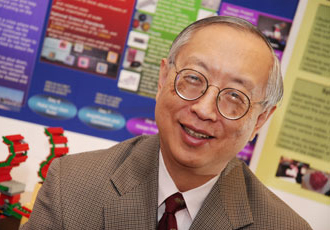Robert Chang Leads Solar Cell Breakthrough
Northwestern University researcher Robert Chang has taken a big step toward the ultimate type of solar cells — ones that can simply be printed on surfaces exposed to sunlight.
Grätzel — or dye-sensitized — cells use a molecular dye that absorbs sunlight and converts the photons’ energy into electricity. By their nature they are economical and environmentally friendly compared with other types of photovoltaic cells that use large quantities of environmentally sensitive or downright toxic materials. Until now a major problem with Grätzel cells has been their use of organic liquid electrolytes which tend to leak and corrode the cells, resulting in a maximum useful life of no more than about 18 months. This drawback, together with low efficiency, has kept such cells from becoming more widely accepted commercially.
A two-decade search for a solid-state replacement for the Grätzel cell’s liquid electrolyte has been unsuccessful until the challenge was taken up by Chang, a Northwestern materials science and engineering professor. He collaborated with Northwestern chemistry professor Mercouri Kanatzidis to come up with a clever alternative — a solution that begins as a liquid but turns solid, making the cell far more stable and durable.
In Chang’s cell, a thin-film compound made up of cesium, tin and iodine, called CsSnI3, replaces the entire liquid electrolyte of the Grätzel cell.
“This is the first demonstration of an all solid-state dye-sensitized solar cell system that promises to exceed the performance of the Grätzel cell,” Chang said. “Our work opens up the possibility of these materials becoming state of the art with much higher efficiencies than we’ve seen so far.”
“The Grätzel cell is like having the concept for the light bulb but not having the tungsten wire or carbon material,” said Kanatzidis, of the need to replace the troublesome liquid. “We created a robust novel material that makes the Grätzel cell concept work better. Our material is solid, not liquid, so it should not leak or corrode.”
The new cell’s energy conversion efficiency of 10.2% is the highest reported so far for a solid-state solar cell equipped with a dye sensitizer. The highest reported performance for a Grätzel cell is about 11 to 12%, considerably lower than conventional silicon solar cells that can convert upwards of 20% of sunlight into electricity. Despite the relative inefficiency, dye-sensitized cells are attractive because they have the potential to be more economical now that the liquid electrolyte problem has been solved.
Chang’s cell is different from the Grätzel cell because it uses both n-type and p-type semiconductors and a monolayer dye molecule serving as the junction between the two. Each nearly spherical nanoparticle, made of titanium dioxide, is an n-type semiconductor. Kanatzidis’ CsSnI3 thin-film material is a new kind of soluble p-type semiconductor.
A single solar cell measures half a centimeter by half a centimeter and about 10 microns thick. The dye-coated nanoparticles are packed in, and Kanatzidis’ new material, which starts as a liquid, is poured in, flowing around the nanoparticles. Much like paint, the solvent evaporates, and a solid mass results. The sunlight-absorbing dye, where photons are converted into electricity, lies right between the two semiconductors.
“Our inexpensive solar cell uses nanotechnology to the hilt,” Chang said. “We have millions and millions of nanoparticles, which gives us a huge effective surface area, and we coat all the particles with light-absorbing dye.”
Chang chose nanoparticles of about 20 nanometers in diameter. This size optimizes the device, he said, increasing the surface area and allowing enough space between the particles for Kanatzidis’ material to flow through and set.
Another big improvement is that the conducting electrolyte material CsSnI3 itself absorbs light — more light over a wider range of the visible spectrum than the dyes used in most Grätzel cells. That additional increment of light-absorption boosts the efficiency of the new Chang-Kanatzidis cell.
“This is only the beginning,” Chang said. “Our concept is applicable to many types of solar cells. There is a lot of room to grow.”
The lightweight thin-film structures can be produced through efficient mass-production processes. The next step for Chang and Kanatzidis is to scale up their creation by building a large array of cells.
In addition to Chang and Kanatzidis, postdoctoral fellow In Chung in the Kanatzidis group and graduate student Byunghong Lee in the Chang group worked to help develop the new cells, achieving performance gains that averaged out to about 1% per month.
The paper detailing their study is titled “All-Solid-State Dye-Sensitized Solar Cells With High Efficiency” and was published in the journal Nature.
The work was supported by the National Science Foundation, the U.S. Department of Energy and the Initiative for Energy and Sustainability at Northwestern (ISEN).

Northwestern professor Robert Chang has led a significant breakthrough toward durable, lightweight solar cells that can be manufactured economically.

